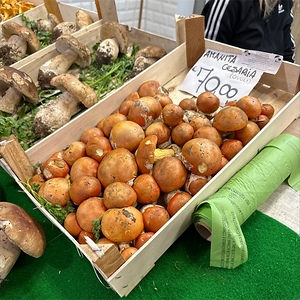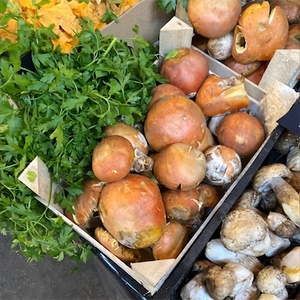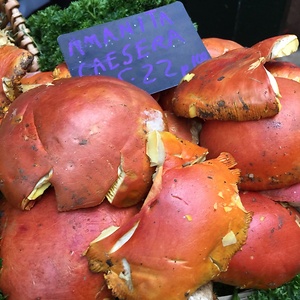


Caesar's Mushrooms
Estimated Inventory, lb : 0
Description/Taste
Caesar’s mushrooms are variable in size, depending on their maturity at harvest, but are typically small to medium, averaging 3 to 8 centimeters in diameter. The caps have a distinct round, oval, or curved, egg-like shape when young, the desired stage for culinary use. If left to mature, the caps would expand into a convex shape, growing as large as 6 to 15 centimeters in diameter with striated edges. Young Caesar’s mushrooms are sometimes covered in a white veil known as the volva that can envelop the stem and edges of the cap. The caps showcase rich red-brown golden hues and are described as sharing the same color as egg yolks. The caps are taut, firm, springy, and fragile. Underneath the caps, yellow-tinted gills are crowded and free-standing, not attached to the stem. The stems, also known as stipes, are thick, fleshy, and range from 8 to 15 centimeters in length. The stems exhibit ivory to white hues and are often covered in specks of dirt. When sliced in half, Caesar’s mushrooms have a spongy, soft, and semi-firm consistency. They also notably have a yellow tint, a distinct feature of the variety. Once cooked, they become slippery, tender, and subtly chewy. Caesar’s mushrooms have a delicate flavor and can be eaten raw or cooked. Raw mushrooms have a subtly sweet and nutty taste reminiscent of chestnuts or hazelnuts, while cooked mushrooms become mellow, savory, and sweet.
Seasons/Availability
Caesar’s mushrooms are available from late summer through early winter. In Italy, the variety is harvested between September and November.
Current Facts
Caesar’s mushrooms, botanically classified as Amanita caesarea, are a European variety belonging to the Amanitaceae family. The seasonal mushrooms typically appear after the first rain in the late summer and early fall and are a wild, foraged species. Caesar’s mushrooms grow individually or in small groupings and are found on the ground, primarily near oak trees in forests. The species naturally grows throughout Europe but is highly prized in Italy, where it has been utilized as a culinary ingredient since ancient times. Caesar’s mushrooms acquired their empyrean title as “Caesar” in Italy is used to describe something “elegant, large, or a specialty product.” The species is also known as Ovoli, Ovolo, Ovolo Buono, Ouronjo, and Fungo Reale. Ovolo translates from Italian to mean “little egg” and is given to the mushroom for its “button, egg-like stage,” when the caps are closed, young, and have a compact oval nature. This is the stage where the variety is traditionally harvested for culinary use. It is important to note that Caesar’s mushrooms have several poisonous look-alikes, including Amanita phalloides, Amanita virosa, and Amanita muscaria. In Italy, Caesar’s mushrooms can only be sold in commercial markets after a mycologist has examined them to confirm that they are edible and the correct species. Once the mushrooms are inspected, they are sold as a rare delicacy. Caesar’s mushrooms are consumed in raw or cooked culinary preparations and are valued for their delicate flavoring.
Nutritional Value
Caesar’s mushrooms are not extensively used in medicinal applications as the species is rare and mainly reserved for culinary preparations. The mushrooms are a source of fiber to regulate the digestive tract, potassium to balance fluid levels, and magnesium to control nerve functions. The species also provides copper to develop red blood cells, zinc and vitamin C to support the immune system, phosphorus to protect bones and teeth, and other nutrients, including B vitamins, manganese, calcium, and iron.
Applications
Caesar’s mushrooms have a delicate, lightly sweet, and nutty taste suited for fresh and cooked preparations. The species is considered a specialty culinary ingredient and treated as a delicacy versus an everyday mushroom. Due to their short shelf life, Caesar’s mushrooms are typically prepared in home kitchens. Some restaurants serve the variety, but it is often for a limited period and a luxury dish. Caesar’s mushrooms should be cleaned and lightly shaved with a knife. Once prepped, the mushrooms are popularly sliced with a mandolin to create thin pieces. In Rome, Caesar’s mushrooms are famously served raw in salads. The mushrooms are sliced, tossed with olive oil, parsley, garlic, and parmesan, and served as a side dish to fish or meat. Each family in Italy has their own recipe variation, and the mushroom salad is commonly paired with a crisp and chilled white wine. Caesar’s mushrooms can also be sprinkled with salt and lemon juice or lightly sauteed as a simple dish. The variety must not be overcooked as it will lose its delicate flavor. It should also be paired with lighter ingredients to not overpower its taste. Caesar’s mushrooms can be cooked with garlic and spread on toast, combined with sausage, cooked into risotto, or grilled with other vegetables. Caesar’s mushrooms pair well with lemon juice, olive oil, red wine vinegar, celery, red peppers, spinach, other leafy greens, and parmesan cheese. The variety has a short shelf life and should be immediately consumed for the best quality and flavor. When stored in the refrigerator, the mushrooms need ample air circulation and will last up to three days.
Ethnic/Cultural Info
Caesar’s mushrooms are tied to a famous Italian story of the poisoning of Emperor Claudius from 50 to 60 CE. Caesar’s mushrooms are edible and not dangerous, but they are a part of the Amanita genus, a botanical grouping known for its other deadly members. Several Amanita species are known as “mushrooms that can only be eaten once in a lifetime,” as most consumers do not survive the experience. Legend has it that Emperor Claudius loved eating Caesar’s mushrooms, and it was one of his favorite meals. One night, his wife Agrippina joined forces with a professional poisoner to murder the emperor to allow her son to take his place. Emperor Claudius was fed a mixture of Caesar’s mushrooms combined with Amanita phalloides, more commonly known as the Death Cap. The emperor was poisoned, and rumor has it that the medic that was sent to treat him also fed the emperor additional types of poison to combine with the fatal mushrooms to finalize the assassination. After Claudius’ passing, Agrippina’s son, Nero, succeeded Claudius as emperor, fulfilling the desired outcome of the assassination plot.
Geography/History
Caesar’s mushrooms are native to regions of southern Europe and North Africa and have been growing wild since ancient times. In Europe, the species’ native distribution range spans across the Black Sea basin, Caucasus region, and the Mediterranean. Much of the species’ use in ancient civilizations is unknown, but there are numerous speculations and theories, especially within the culinary history of Italy. Over time, historians hypothesized that Roman armies contributed to the spread of the species as populations of the mushroom are often found along ancient Roman roadways. Caesar’s mushrooms were first recorded in written documents by Italian naturalist Giovanni Antonio Scopoli in 1772 and were later reclassified into the Amanita genus in 1801 by mycologist Christian Hendrik Persoon. The species has a mycorrhizal relationship with the roots of various trees, especially pine, chestnut, and oak. Today, Caesar’s mushrooms are localized to regions of Europe, Africa, and Asia. Two other similar species, Amanita jacksonii and Amanita arkansana, are found in the Americas, but these are distinct from the European Caesar’s species. When in season, Caesar’s mushrooms are picked from wild populations and are sold in fresh markets. The Caesar’s mushrooms featured in the photograph above were sourced from the forests near Lago di Bolsena in Lazio, Italy. This region is known for its humidity, mild climate sustained by the lake, and shady forested areas with rich, moist soil. Once harvested, these mushrooms were sold and purchased through a vendor in Mercato Trionfale in Rome, Italy.
Recipe Ideas
Recipes that include Caesar's Mushrooms. One
Podcast










